Linux-based CUE system to debut on 2012 Cadillacs
Oct 12, 2011 — by Eric Brown — from the LinuxDevices Archive — 9 viewsCadillac announced a Linux-based in-vehicle infotainment (IVI) and navigation system that will debut in the 2012 Cadillac XTS. The Cadillac User Experience (CUE) system's triple-core ARM11 processor controls both an eight-inch capacitive multitouch main touchscreen and an optional 12.3-inch cluster display, and features proximity sensing, haptic feedback, natural language voice recognition, and an open app development platform.
Cadillac began development on Cadillac User Experience (CUE) in 2008, and will debut the technology in 2012 in the Cadillac XTS, the automaker said in an Oct. 12 announcement. The XTS debut will be followed shortly thereafter by appearances in the ATS luxury sedans and SRX luxury crossovers, and CUE will then spread to other Cadillac models.
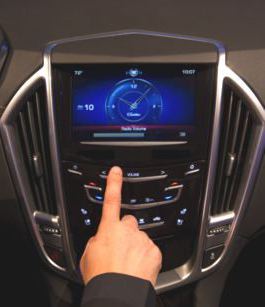
Cadillac User Experience (CUE) main screen and console
According to a "first look" story on Autoblog, two of the processor's cores are adapted to handle voice processing. This would suggest that at least one of them is a digital signal processor (DSP) as opposed to an ARM core.
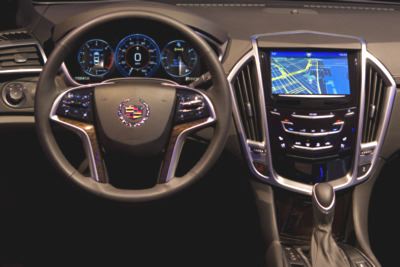
CUE installed in a Cadillac XTS
The system supports Bluetooth 3.0, and is designed to orchestrate I/O from up to 10 Bluetooth-enabled mobile devices, says Cadillac. It is also said to offer dual USB ports, an SD card slot, and an MP3 player dock.
The CUE system offers onboard navigation tools, weather maps with doppler radar, AM/FM and XM radio, and integration of rear-facing camera input. The system acts as a portal to instant messages and emails arriving via attached mobile devices, says the company. A rear-seat BluRay entertainment system will also be available, according to Autoblog.
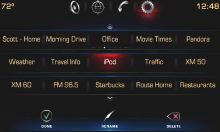
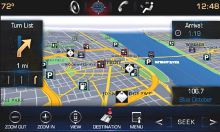
CUE main-screen UI, including home screen (left) and navigation app
(Click on either to enlarge)
The CUE system features a number of industry firsts, claims Cadillac. These are said to include full multitouch capability on the capacitive screen. Gestures can include tap, flick, swipe, and spread, helping to ease tasks such as scrolling lists, zooming maps, and searching favorites, says the company.
Resistive touchscreens are still the norm in automotive computers, and adapting the capacitive technology for automotive applications was a particular challenge for Cadillac, notes Autoblog.

Another view of CUE console
Source: Autoblog
In addition, CUE offers natural speech recognition for most commands. The computer also features text-to-speech and speech-to-text features for listening to and recording text messages, says Cadillac.
The main display is said to show the driver's five most frequently used functions on the top of the screen. The bottom part of the display shows up to 60 user-configurable "favorites," which can include music, points of interest, addresses, maps, phone numbers, or system commands, says the company.
Gauge cluster integrates OnStar
Selected Cadillac models will also feature a CUE-powered 12.3-inch LCD gauge cluster behind the wheel. The reconfigurable cluster offers four selectable displays — simple, enhanced, balanced, and performance — that offer different detail levels. These can include traditional vehicle data such as a speedometer and fuel gauge, as well as navigation, entertainment, and 3D vehicle imaging, says Cadillac.

CUE gauge cluster
Source: Autoblog
(Click to enlarge)
CUE can also integrate OnStar's safety, security, and connectivity services, such as turn-by-turn navigation, automatic crash notification, hands-free calling, and the OnStar RemoteLink mobile application. OnStar features are said to be integrated via CUE's main infotainment screen, as well as the gauge cluster.
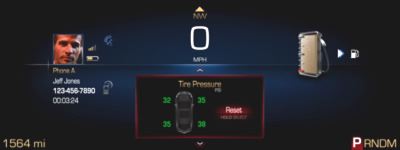
Another view of CUE gauge cluster
A "massive step in the right direction"
According to Autoblog's Damon Lavrinc, CUE does indeed break ground on several fronts, and appears to compare well with competing luxury-car IVI systems such as BMW's iDrive, Audi's MMI, "and the (aging) COMAND setup" from Mercedes-Benz.
"While we wouldn't call the UI achingly attractive, the functionality is there in spades, starting with the applications," writes Lavrinc, speaking of the main screen UI. Lavrinc goes on to praise the voice recognition feature, and gives top marks to the cluster display.
"The CUE's LCD instrument panel is the first truly user-customizable setup," he writes, noting the four available complexity options. According to Lavrinc, one cool feature that may or may not make it into the first shipping version is the ability to swipe a navigation destination or radio element from the main screen to the instrument panel, as in a dual-display setup.
"The team at Cadillac has finally developed a system inside that matches their forward-looking exteriors," concludes Davrinc, noting that pricing is not yet available. "That's a massive step in the right direction. Now they just have to execute it."
Stated Don Butler, vice president, Cadillac Marketing, "For the tech-savvy, [CUE is] everything you want it to be — a full suite of infotainment, navigation and communication tools that keeps you fully connected. For the tech-averse, its power is remarkably simple, intuitive and accessible."
Availability
Cadillac will debut the CUE technology in 2012 in the Cadillac XTS, says the company. More information, including a video, may be found in this CUE announcement.
This article was originally published on LinuxDevices.com and has been donated to the open source community by QuinStreet Inc. Please visit LinuxToday.com for up-to-date news and articles about Linux and open source.